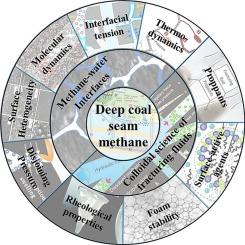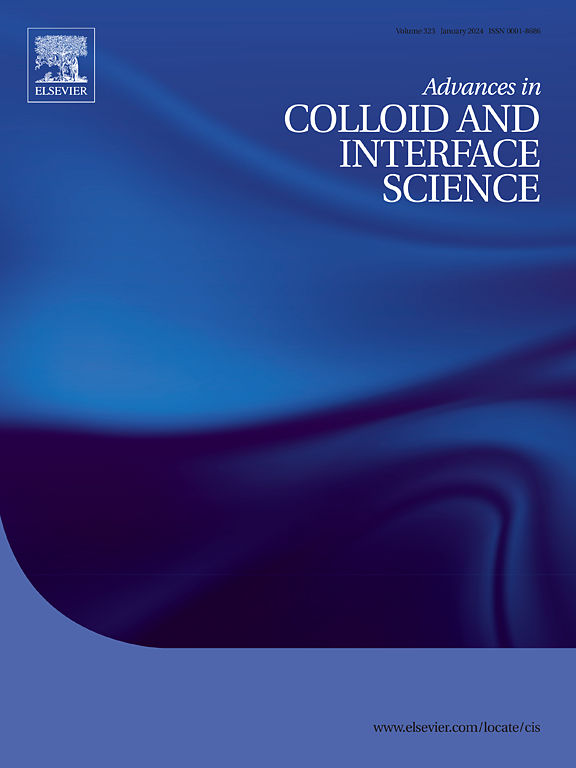In-depth review of colloidal and interfacial fundamentals in fracturing development of deep coal seam methane
IF 19.3
1区 化学
Q1 CHEMISTRY, PHYSICAL
引用次数: 0
Abstract
Deep coal seam methane represents a significant global energy resource, but its efficient extraction requires specialized fracturing technologies that address the unique characteristics of coal formations. This review provides a comprehensive examination of the fundamental colloidal and interfacial phenomena governing fracturing processes in deep coal seam methane development, with particular emphasis on the behavior of methane-water interfaces, the colloidal science of fracturing fluids, and transport mechanisms at the pore scale. The distinct properties of methane-water interfaces under confinement in coal micropores are analyzed, revealing how surface heterogeneity, temperature, pressure, and salinity influence interfacial tension, wettability, and fluid distribution. The extreme conditions of deep coal seams, characterized by high pressures (10–30 MPa) and elevated temperatures (>80 °C), significantly alter these interfacial dynamics compared to conventional reservoirs. The review explores the complex rheological behavior and stability mechanisms of foam-based fracturing fluids, including the roles of liquid drainage, coarsening, and bubble coalescence in determining foam performance under reservoir conditions. Special attention is given to surfactant molecular design, synergistic formulations, and the emerging field of viscoelastic surfactants that offer enhanced stability and rheological control. These formulations must be specially designed to withstand the extreme pressure-temperature regimes of deep coal seams while mitigating the swelling and strain characteristics unique to coal matrices. The colloidal aspects of proppant transport and placement in coal fractures are examined, highlighting the importance of proppant-fluid interactions and specialized lightweight materials for maintaining fracture conductivity. This review provides fundamental insights for developing next-generation fracturing technologies that enhance methane recovery in deep coal seam operations.

深层煤层气压裂发育中的胶体和界面基本原理综述
深层煤层甲烷是一种重要的全球能源资源,但其高效开采需要专门的压裂技术,以解决煤层的独特特征。本文综述了深层煤层甲烷开发中控制压裂过程的基本胶体和界面现象,特别强调了甲烷-水界面的行为、压裂液的胶体科学以及孔隙尺度上的输运机制。分析了煤微孔约束下甲烷-水界面的不同性质,揭示了表面非均质性、温度、压力和盐度如何影响界面张力、润湿性和流体分布。与常规储层相比,深部煤层的极端条件,以高压(10-30 MPa)和高温(>80℃)为特征,显著改变了这些界面动力学。本文探讨了泡沫基压裂液的复杂流变行为和稳定性机制,包括储层条件下液体排液、粗化和气泡聚结在决定泡沫性能方面的作用。特别关注表面活性剂的分子设计,协同配方,以及提供增强稳定性和流变性控制的粘弹性表面活性剂的新兴领域。这些配方必须经过专门设计,能够承受深部煤层的极端压力-温度状态,同时减轻煤基质特有的膨胀和应变特性。研究了支撑剂在煤层裂缝中运移和放置的胶态方面,强调了支撑剂-流体相互作用和专用轻质材料对维持裂缝导流能力的重要性。该综述为开发下一代压裂技术提供了基础见解,这些技术可以提高深煤层作业中甲烷的采收率。
本文章由计算机程序翻译,如有差异,请以英文原文为准。
求助全文
约1分钟内获得全文
求助全文
来源期刊
CiteScore
28.50
自引率
2.60%
发文量
175
审稿时长
31 days
期刊介绍:
"Advances in Colloid and Interface Science" is an international journal that focuses on experimental and theoretical developments in interfacial and colloidal phenomena. The journal covers a wide range of disciplines including biology, chemistry, physics, and technology.
The journal accepts review articles on any topic within the scope of colloid and interface science. These articles should provide an in-depth analysis of the subject matter, offering a critical review of the current state of the field. The author's informed opinion on the topic should also be included. The manuscript should compare and contrast ideas found in the reviewed literature and address the limitations of these ideas.
Typically, the articles published in this journal are written by recognized experts in the field.

 求助内容:
求助内容: 应助结果提醒方式:
应助结果提醒方式:


